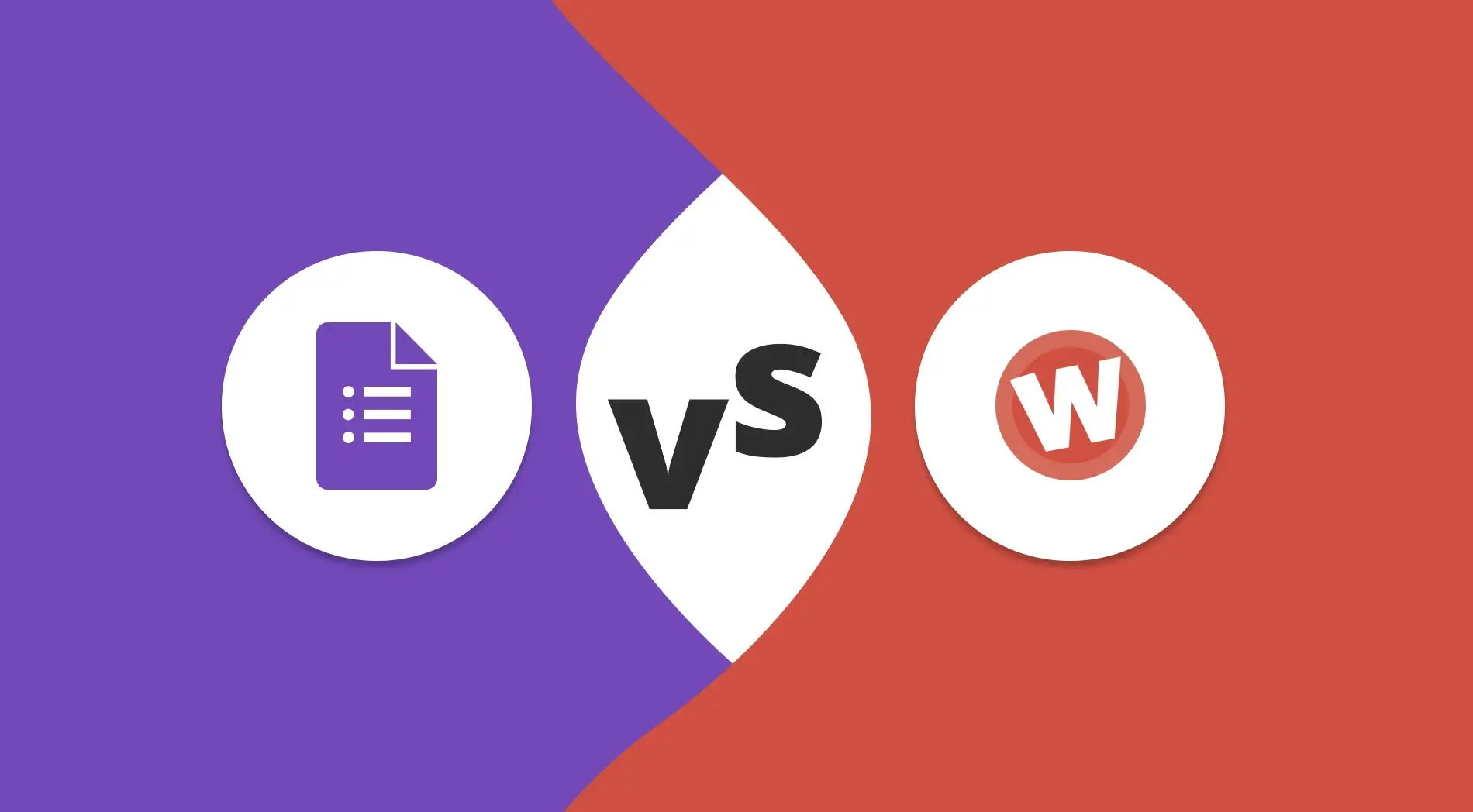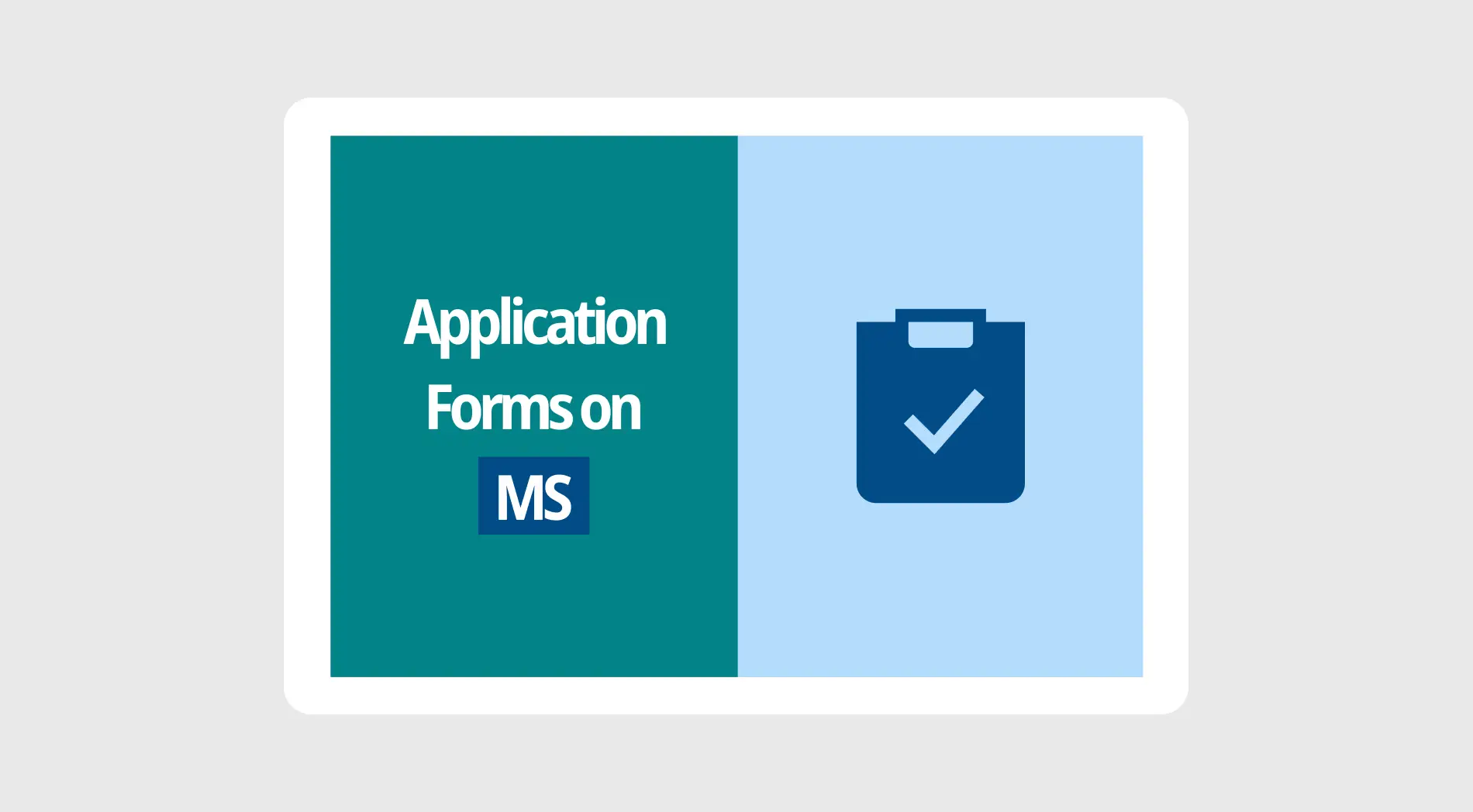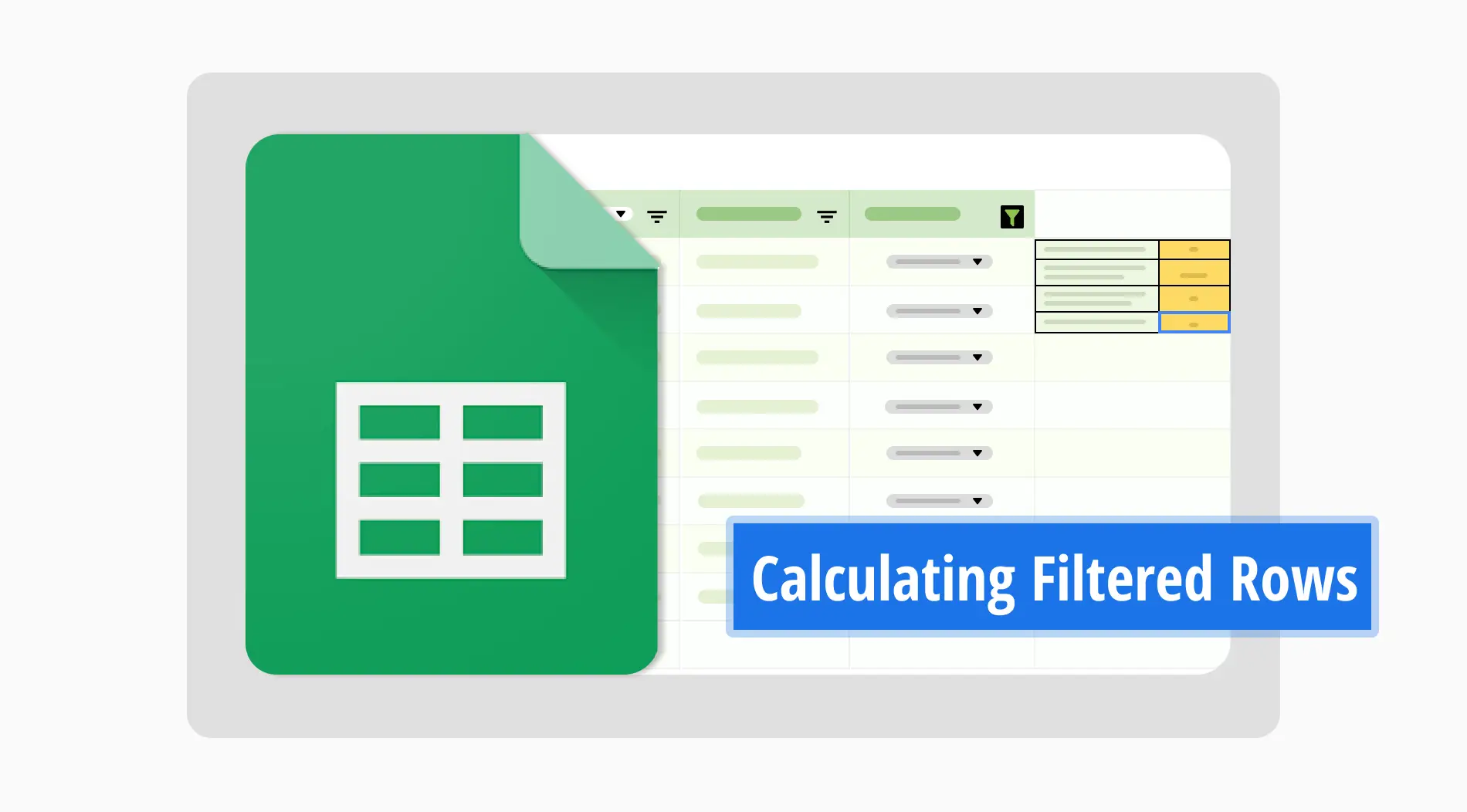Os construtores de formulários online tornaram-se uma parte crucial dos negócios modernos, ajudando empresas a criar documentos da web, gerenciar a coleta de dados e até mesmo aceitar pagamentos em tempo real. Se você já está familiarizado com a criação de formulários, é provável que você ou sua equipe tenham criado formulários como o Google Forms. Sem dúvida, é uma plataforma amigável para o usuário, mas existem mais ferramentas disponíveis no mercado.
Ao começarmos a explorar alternativas ao Google Forms, este artigo irá compará-lo com outro concorrente popular - Wufoo. Vamos analisar detalhadamente as características e destaques de cada plataforma para determinar se o Google Forms ou o Wufoo se destacam. Além disso, você vai descobrir uma solução ainda melhor que pode se tornar a escolha principal da sua empresa.
Google Forms vs. Wufoo à primeira vista
Antes de mergulharmos nos detalhes e características, vamos começar com uma visão geral dessas ferramentas. Esta rápida olhada irá ajudá-lo a entender o que elas são, quão adequadas elas podem ser para a sua empresa e se elas podem atender às suas necessidades específicas. A primeira impressão é crucial, pois escolher o serviço certo irá melhorar significativamente o processo de criação de formulários.

A página inicial do Google Forms
O Google Forms cria um espaço online amigável para empresas e indivíduos coletarem dados através de formulários personalizáveis. Como parte do Google Workspace, é facilmente acessível e gerenciável para qualquer pessoa com uma conta do Google. Sua acessibilidade torna o Google Forms ideal para pequenas empresas, startups e propósitos educacionais, fornecendo rápida criação de formulários e coleta de respostas diretamente no Google Sheets.
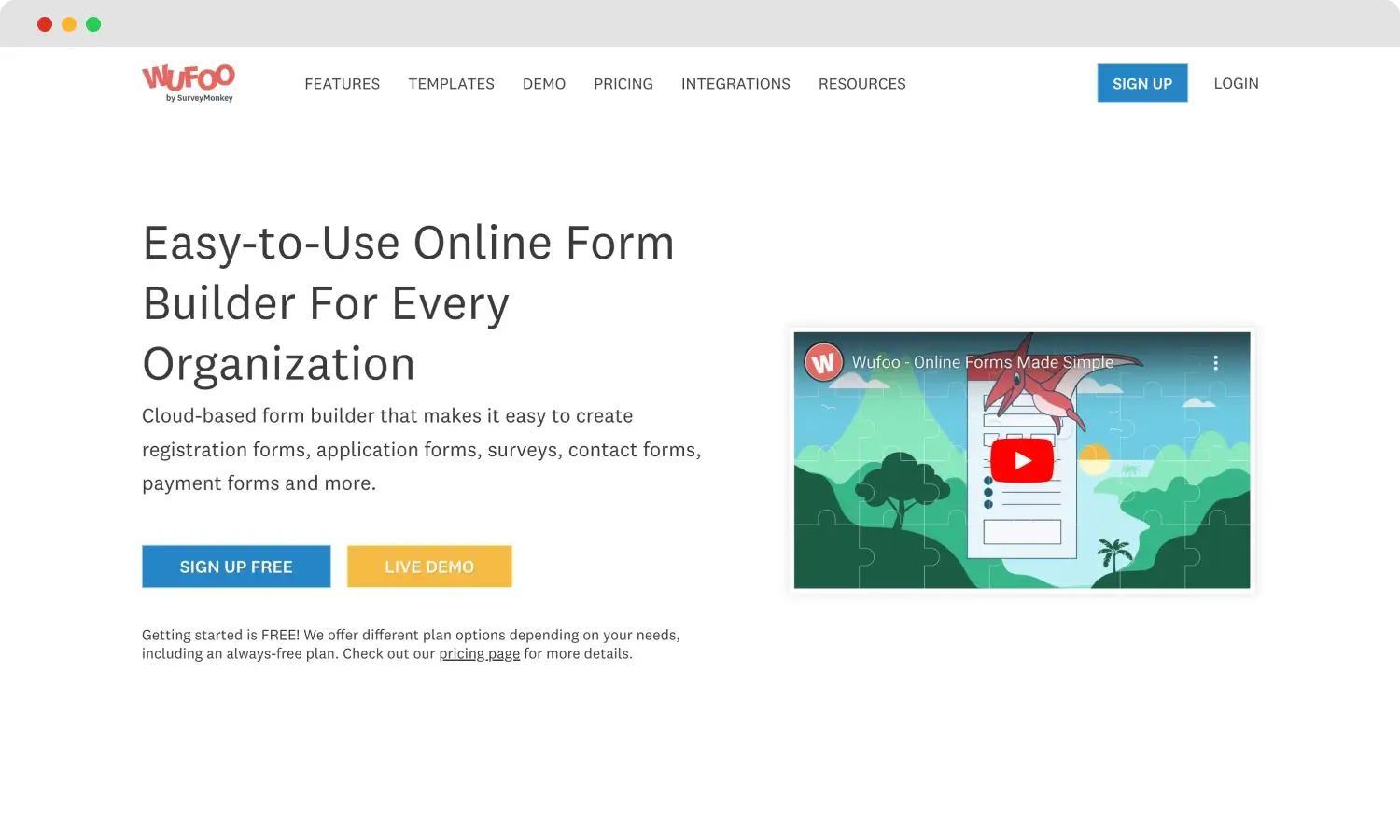
A página inicial do Wufoo
Wufoo, uma ferramenta de criação de formulários baseada na nuvem da plataforma SurveyMonkey, se destaca em versatilidade. Enquanto o SurveyMonkey se concentra em pesquisas de marketing avançadas e complexas e formulários empresariais, atendendo a especialistas e necessidades de conformidade, o Wufoo é ideal para criar formulários multiuso. Isso ajuda você a coletar pagamentos, gerenciar dados, e criar vários documentos da web com facilidade.
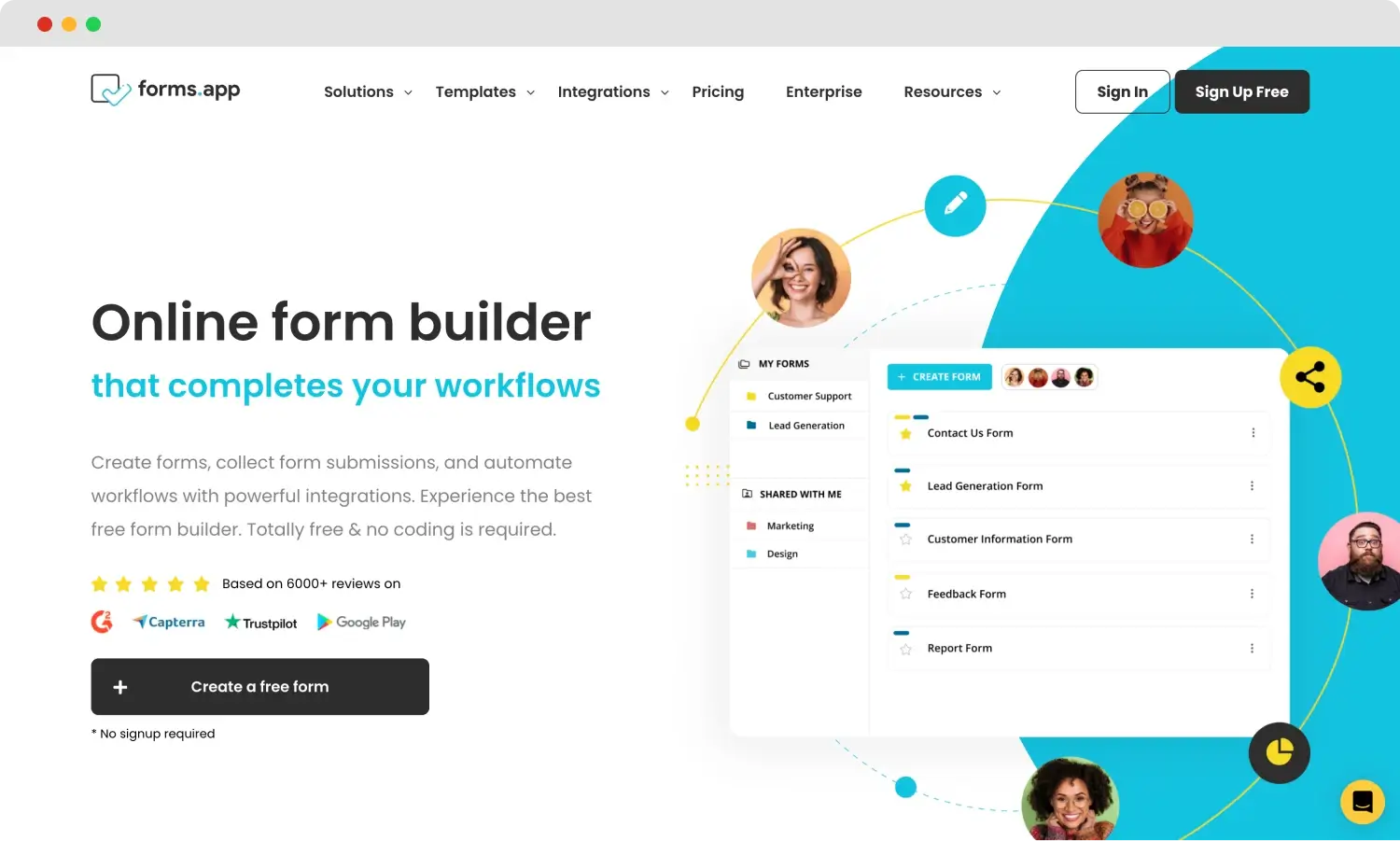
A página inicial do forms.app
Se você está procurando uma plataforma para criar todos os tipos de formulários que também atendam às suas necessidades empresariais com excelentes ferramentas de relatório e integrações de pagamento, não procure mais do que o forms.app. Ele reúne os melhores recursos em um serviço conveniente. Suas avançadas capacidades de IA ajudam você a construir formulários rapidamente, tornando seu trabalho mais rápido e eficiente.
Google Forms vs. Wufoo: 7 pontos essenciais
Agora é hora de mergulhar nos detalhes e explorar todos os recursos e destaques passo a passo. Ao comparar Google Forms e Wufoo, abordaremos 7 fatores principais, como planos de preços, modelos de formulários, ferramentas especiais de colaboração, e mais. Considere ficar conosco para garantir que você tome a decisão certa mais tarde.
1. Preços

Comparação de preços entre Google Forms, Wufoo e forms.app
Falando sobre os preços de cada ferramenta, o Google Forms se destaca por ser gratuito, o que é realmente tentador. No entanto, as empresas podem considerar assinar o Google Workspace para aprimorar seus fluxos de trabalho e acessar aplicativos adicionais. Este plano tudo-em-um inclui o Google Forms juntamente com outras ferramentas como Gmail, Google Drive, e Google Sheets. Considere rever os planos de preços do Google Forms:
Esta plataforma é gratuita✅
Planos do Google Workspace
- Starter Empresarial: $7,20/ usuário por mês
- Standard Empresarial: $14,40/ usuário por mês
- Plus Empresarial: $21,60/ usuário por mês
- Enterprise: Preço personalizado
Wufoo tem um plano gratuito com opções limitadas. Você pode criar até 5 documentos com 10 campos cada e coletar 100 entradas por mês. Para recursos mais avançados, Wufoo oferece quatro planos pagos diferentes a partir de $19 por mês. Esses planos Pro permitem que você colete pagamentos, faça upload de arquivos e remova a marca Wufoo. Considere revisar os planos de preços do Wufoo:
- Plano gratuito ✅
- Starter: $19 por mês
- Profissional: $39 por mês
- Avançado: $99 por mês
- Ultimate: $249 por mês
Embora o Google Forms ofereça recursos limitados e o plano gratuito do Wufoo tenha restrições, você pode considerar forms.app. Ele oferece um plano gratuito com acesso a todos os recursos, modelos de formulários, e campos. Os planos pagos começam em $25 mensais, tornando-o uma escolha ideal para pequenas empresas e uso pessoal. Aqui estão todas as opções de preços:
- Plano gratuito ✅
- Plano Básico: $25 por mês
- Plano Pro: $35 por mês
- Plano Premium: $99 por mês
2. Recursos do formulário
O Google Forms oferece um construtor de arrastar e soltar fácil de usar e uma variedade de tipos de perguntas pré-criados, simplificando o processo de criação do formulário. Você pode exportar os resultados para Planilhas do Google ou baixá-los como arquivos. No entanto, é necessária uma conexão com a internet, o que pode ser problemático se o acesso for instável. Além disso, inclui opções básicas de lógica condicional que podem ser um pouco úteis.
O Wufoo oferece recursos para gerenciar pedidos e pagamentos online através de sua plataforma de pagamento. Você também pode se beneficiar do campo de upload de arquivos e organizar seus dados usando integrações populares. O Wufoo ajuda você a facilmente construir, personalizar e incorporar vários formulários em seu site. No entanto, todos esses recursos essenciais estão disponíveis apenas em planos pagos, então você deve fazer upgrade para usá-los.
Quando concorrentes têm recursos e acesso limitados, optar pelo forms.app pode ser uma escolha inteligente. Você pode usar recursos como lógica condicional robusta, coleta de pagamento fácil, e campos de assinatura eletrônica - todos disponíveis no plano gratuito. Além disso, o forms.app suporta a criação de todos os tipos de documentos da web com ferramentas de IA que ajudam você a criá-los em apenas alguns cliques.

Comparação de recursos entre Google Forms, Wufoo e forms.app
3. Opções de personalização
As capacidades de personalização podem melhorar significativamente a experiência do cliente e melhorar a aparência geral de seus formulários. Com Google Forms, você pode personalizar seus formulários com diferentes fontes, imagens personalizadas, e temas de cores. Embora a personalização seja limitada a layouts e tipos de perguntas padrão, é ideal para aqueles sem habilidades técnicas que precisam criar formulários simples e documentos sem esforço.
Wufoo oferece mais opções de personalização para melhorar a aparência de seus formulários. Você pode usar um dos temas prontos com o Theme Designer ou criar o seu próprio a partir do zero. Para branding personalizado, você pode adicionar o logotipo e elementos de marca da sua organização para combinar com a identidade da sua empresa. Além disso, há CSS personalizado que vai além das opções integradas.
4. Tipos de campos
Google Forms apresenta 11+ tipos de campos diferentes, incluindo Resposta longa, Resposta curta, Escolha múltipla, caixas de seleção, e listas suspensas. Você também pode incorporar imagens ou vídeos com suporte do YouTube, que podem ser adicionados via pesquisa ou link. Além disso, várias configurações para seus campos permitem que você inclua descrições, habilite a validação de resposta, e embaralhe a ordem das opções.
Em contraste, o Wufoo oferece mais tipos de campos para atender às diversas necessidades. A plataforma possui todos os campos essenciais padrão, como Texto de Linha Única, Número, Escolha Múltipla, e Caixas de Seleção. Esses campos são simples e flexíveis, ajudando com várias entradas. Além disso, o Wufoo possui campos mais avançados que são adequados para tipos de dados específicos, como Endereço, E-mail, Telefone, Likert, e Upload de Arquivo.
Quando se trata da melhor plataforma nessa categoria, o forms.app oferece mais de 30 campos práticos, incluindo todos os essenciais e opções únicas como Cesta de Produtos, Assinatura, Campo de Desenho, e Campo de Pagamento. A melhor parte é que todas essas funcionalidades estão disponíveis no plano gratuito, garantindo uma experiência fantástica e agradável para o cliente.
5. Integrações
Embora o número de integrações com o Google Forms não seja muito alto, elas podem ser muito úteis se você gosta de trabalhar com produtos do Google. Ele se conecta a todo o Google Workspace, aprimorando a colaboração e o gerenciamento de envios de formulários. Com um único clique, você pode vincular seu formulário a uma Planilha do Google ou salvar seus dados como arquivos para uso posterior.
Wufoo oferece integrações em destaque com plataformas populares como Mailchimp para marketing por e-mail, Stripe e PayPal para processamento de pagamentos, Planilhas do Google para gerenciamento de planilhas e DocuSign para assinaturas eletrônicas. Além disso, o Wufoo suporta um grande número de aplicativos de terceiros que você pode conectar através da ferramenta Zapier, abrangendo áreas como marketing, CRM, vendas e mais.
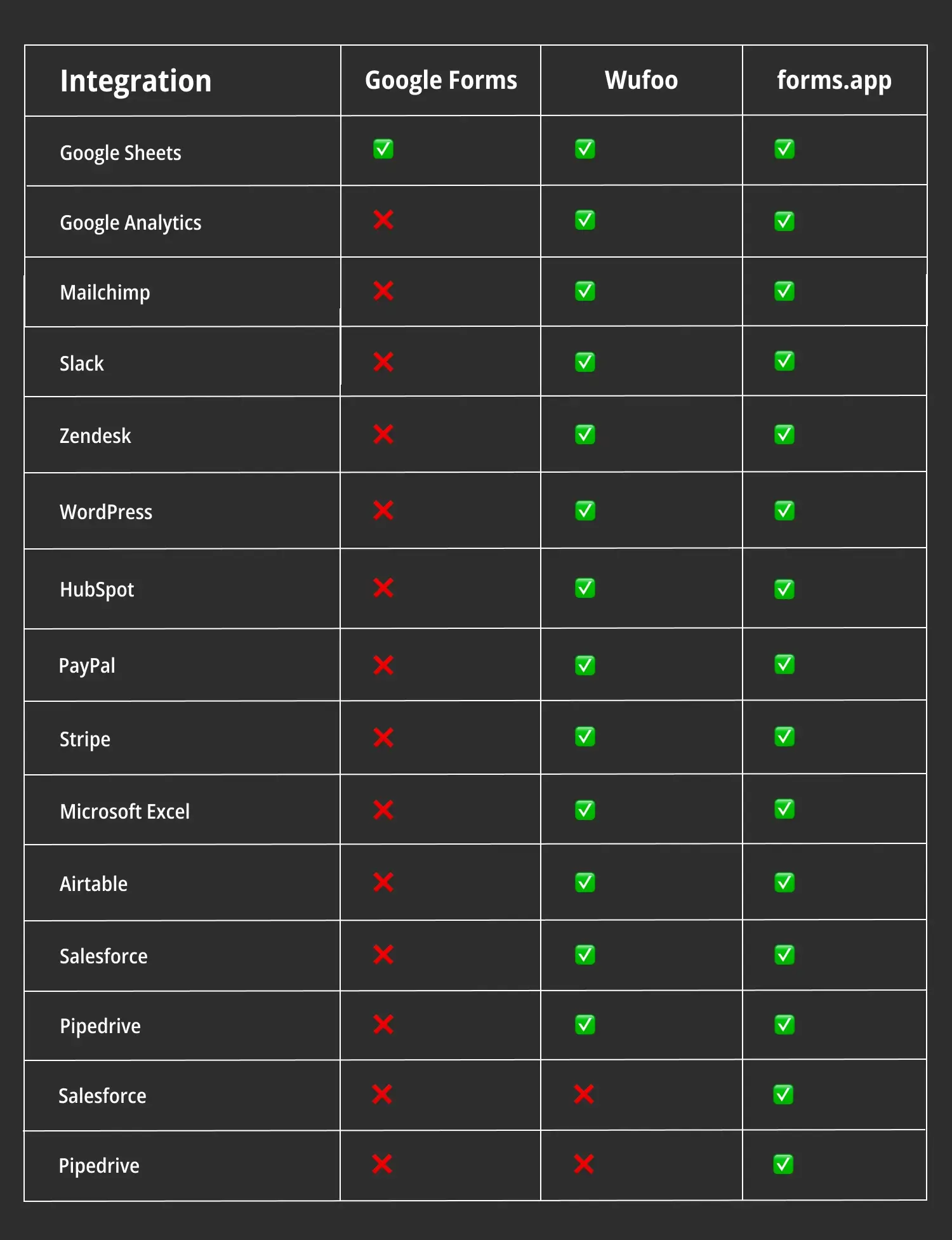
Comparação de integrações entre Google Forms, Wufoo e forms.app
6. Colaboração em equipe
Continuando, o Google Forms tem recursos úteis para colaboração em tempo real entre vários usuários. Você sempre pode convidar membros da equipe para trabalhar em seu documento, dando-lhes acesso total de edição para fazer as alterações necessárias e gerenciar as respostas. Seja trabalhando sozinho ou com uma equipe, o Google Forms suporta a criação e o gerenciamento colaborativo de formulários de forma perfeita.
Você pode convidar novos usuários para uma conta Wufoo para colaborar na construção de formulários, documentos e relatórios com sua equipe. No entanto, esses recursos de colaboração estão disponíveis apenas em planos pagos. Se essas opções não forem suficientes, você pode aprimorar a colaboração da sua equipe conectando o Wufoo a outros aplicativos de produtividade por meio do Zapier, permitindo uma integração perfeita com muitas ferramentas para melhorar o trabalho em equipe.
7. Modelos
Outro fator crucial é a biblioteca de modelos. O Google Forms fornece vários modelos básicos para simplificar a criação de formulários. Esses modelos abrangem necessidades, como formulários de pedidos, registro de eventos, solicitações de trabalho, e feedback de clientes, cada um com temas e perguntas sugeridas. Embora sua biblioteca de modelos não seja vasta, os modelos fornecidos são realmente práticos e fáceis de personalizar.
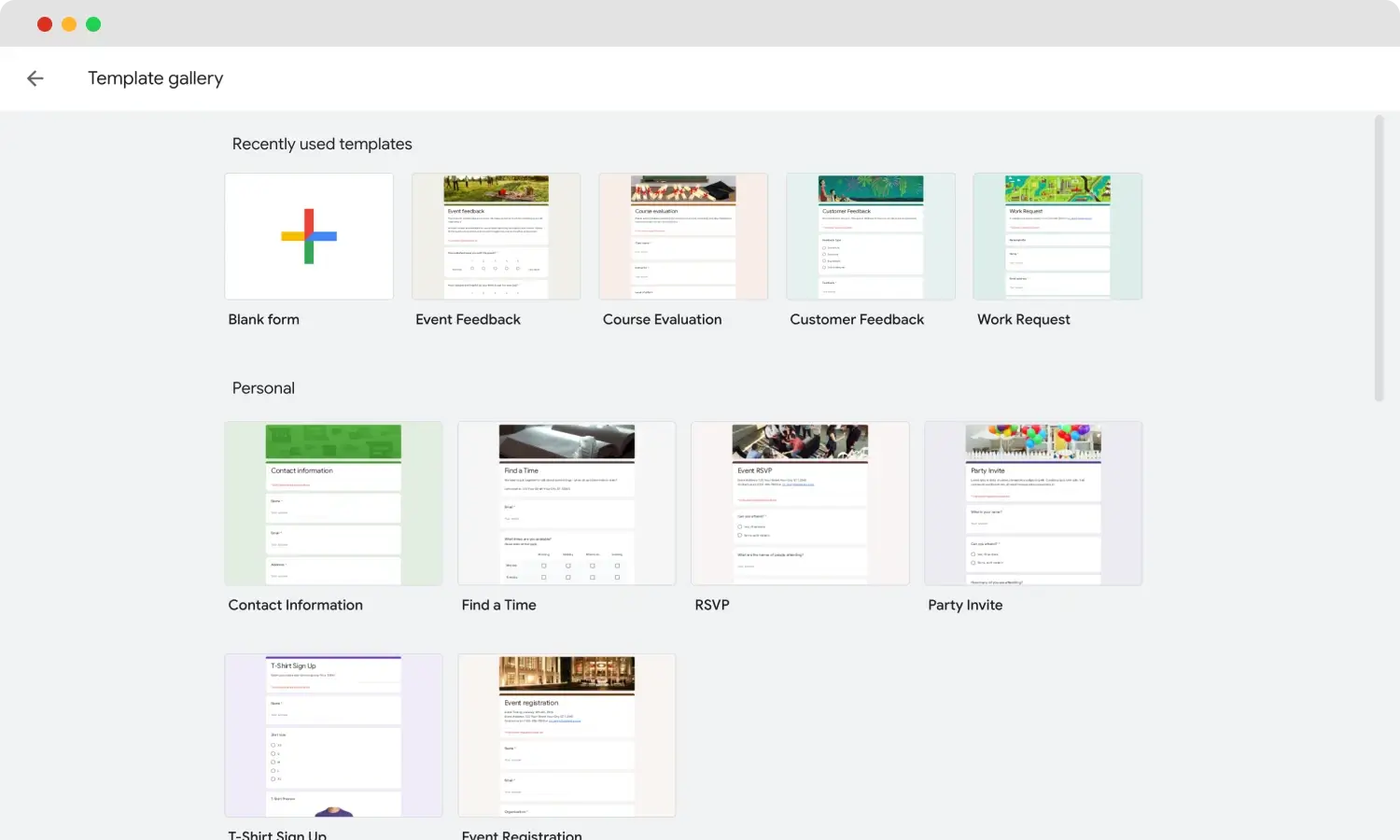
Galeria de modelos do Google Forms
A galeria de formulários do Wufoo possui +400 modelos de formulários diversificados para diferentes propósitos, incluindo convites, geração de leads, pedidos online, registros, e pesquisas. Os usuários podem convenientemente escolher e personalizar vários modelos pré-projetados, como convites de casamento, pesquisas de funcionários, formulários de pesquisa de mercado, e inúmeros tipos de formulários de pedidos.
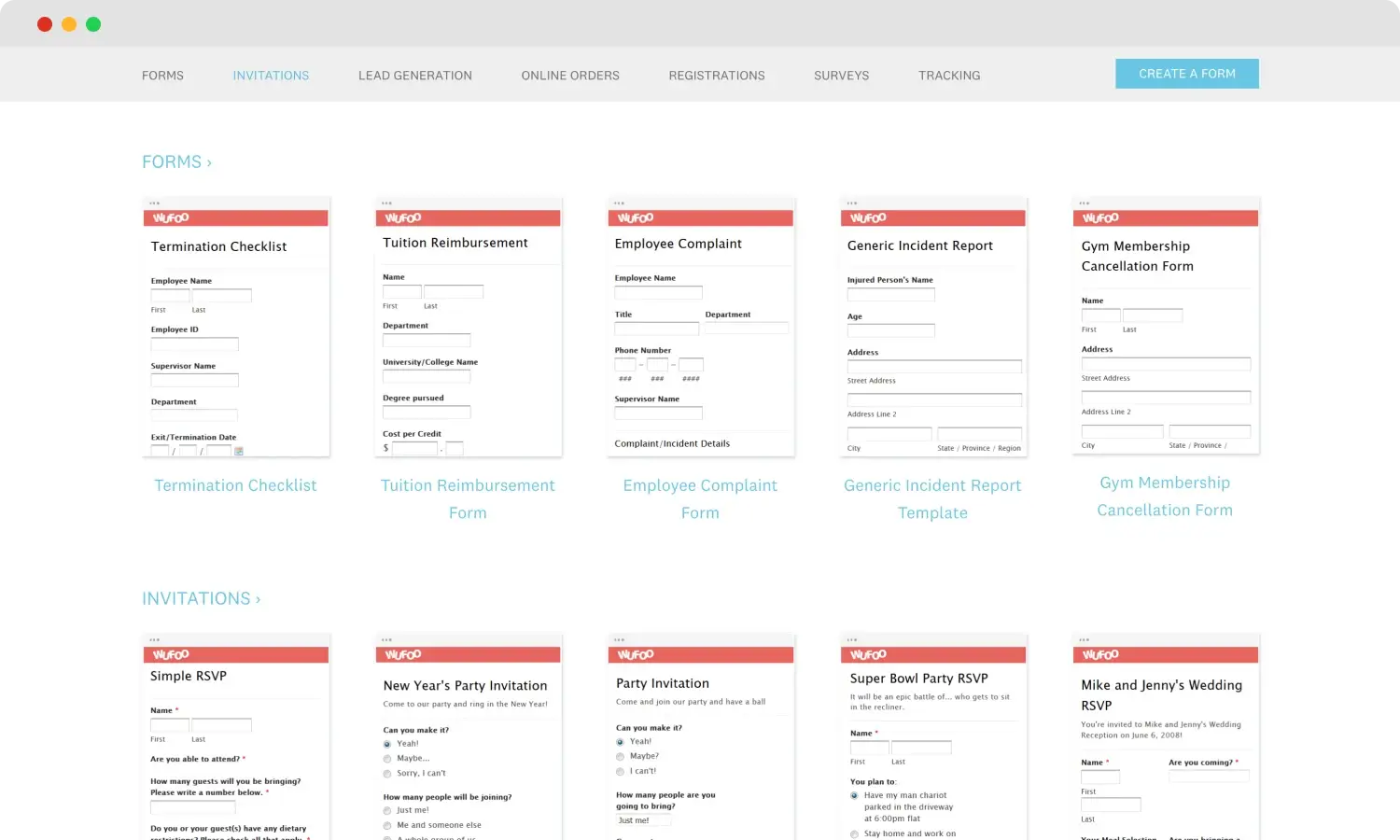
Galeria de modelos do Wufoo
Se uma biblioteca de modelos rica é crucial para os requisitos do seu negócio, considere o forms.app como sua nova plataforma de construção de formulários. Ele se destaca com sua impressionante coleção de +5000 modelos gratuitos, abrangendo formulários, documentos, pesquisas, e questionários. Essa extensa biblioteca garante que existam muitas opções para atender às necessidades comerciais e pessoais, disponíveis em vários idiomas.
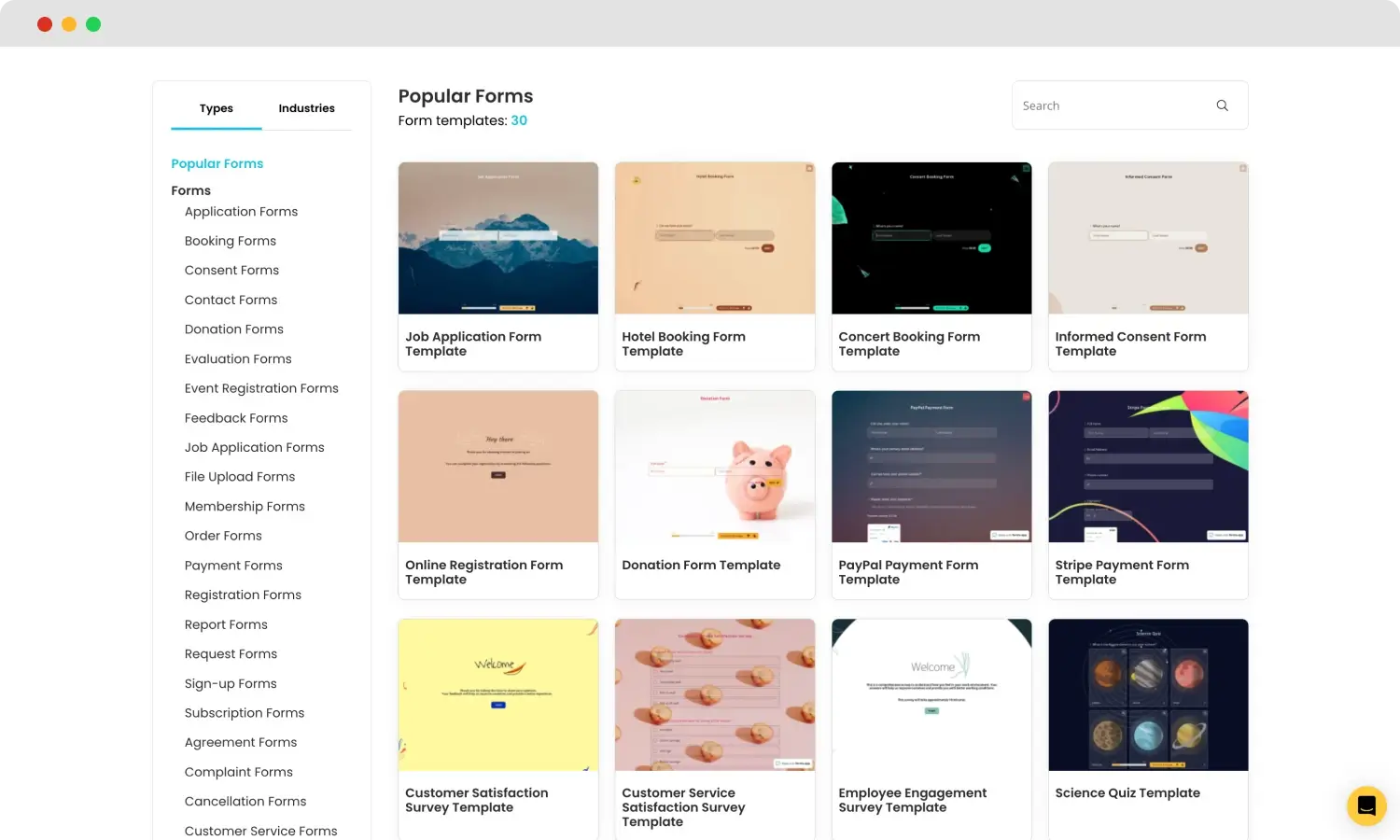
Galeria de modelos do forms.app
Uma alternativa melhor: forms.app
Qualquer serviço online para o seu negócio, especialmente um construtor de formulários, deve ser flexível, fácil de usar com uma interface rápida de aprender, atender a todas as suas necessidades de projeto, e incluir automação para aumentar a produtividade em seu ambiente de trabalho. Depois da nossa comparação passo a passo entre o Google Forms e o Wufoo, você ainda pode ter algumas dúvidas. Nesse caso, considere explorar uma ótima alternativa.
forms.app é um poderoso construtor de formulários online projetado para empresas de todos os tamanhos e propósitos. Com ele, você pode criar formulários atraentes e eficazes para pedidos, pesquisas de marketing, e testes para seus clientes. Além disso, as ferramentas inovadoras de IA do forms.app podem acelerar seu fluxo de trabalho, dando mais tempo para outras tarefas. Abaixo, você pode encontrar suas principais características:
📚 Biblioteca extensiva de modelos: forms.app oferece mais de 5000 modelos projetados por especialistas para diversas necessidades de negócios. Essas soluções prontas simplificam o processo de criação de formulários, economizando tempo para sua equipe.
✨ Interface amigável: Com seu editor intuitivo de arrastar e soltar, qualquer pessoa em sua organização pode criar formulários profissionais sem esforço. Essa facilidade de uso acelera a criação de formulários, levando a prazos de entrega de projetos mais rápidos.
🤖 Poderes de IA: Você pode aumentar a produtividade com as ferramentas inovadoras de IA do forms.app, como Gerador de Formulários IA, Ferramenta de Pesquisa IA, e Criador de Testes IA. Essas ferramentas utilizam tecnologia avançada de IA para otimizar seus fluxos de trabalho e reduzir o esforço manual.
🧩 Integrações perfeitas: Com o forms.app, você aumentará a produtividade da sua equipe com integrações perfeitas com aplicativos de negócios populares, como Slack, HubSpot, WordPress, Stripe, PayPal, e Google Drive.
📊 Análises e relatórios: A plataforma oferece recursos de análise de dados, incluindo análises e relatórios em tempo real. Essas ferramentas ajudam você a rastrear envios de formulários, obter insights e melhorar seus formulários.
Conclusão
Em resumo, vários fatores devem ser considerados ao escolher um construtor de formulários adequado às necessidades de negócios. Estes incluem diversas opções de modelos, integrações extensas, recursos de IA para automação, gateways de pagamento perfeitos eferramentas robustas de colaboração em equipe. Cada um desses elementos desempenha um papel importante em aprimorar a eficiência e a produtividade em um ambiente de negócios.
Este artigo comparou Google Forms e Wufoo, deixando a decisão sobre qual se adequa melhor às necessidades específicas da sua organização com você. No entanto, se você está procurando uma plataforma perfeitamente adequada para fins comerciais e equipada com todos os recursos essenciais, considere explorar uma excelente alternativa - forms.app.
forms.app, seu criador de formulários gratuito
- Visualizações ilimitadas
- número ilimitado de perguntas
- notificações ilimitadas
